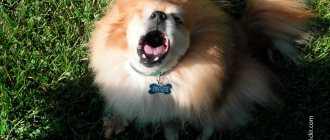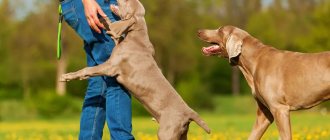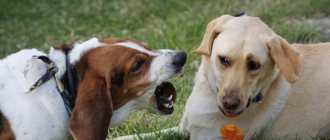Most owners associate the image of a four-legged pet with friendliness and affection. That is why inappropriate behavior, when a dog is afraid of people, causes bewilderment and requires an analysis of the reasons. As a rule, such a strange reaction hides a serious traumatic experience in the animal’s past life. Read our article on how to identify negative factors and correct your dog’s behavior.
Reasons for strange animal behavior
An owner can encounter a dog’s fear of humans both when the animal is an adult and when a puppy appears in the house.
At the puppy's
A young pet’s wary attitude towards a two-legged creature is a common reaction, usually associated with the animal’s low socialization. If the puppy has had little contact with humans and has not been picked up, then in the first days in the new home the animal will behave separately, avoid communication with household members, run away and hide.
This behavior is often observed when an unscrupulous breeder removes puppies from their mother early and keeps them isolated, in cages or enclosures. In this case, the kids communicate little with the person; he represents something unknown and scary to them, and subsequently the animals will experience fear.
Cruel actions of the owner towards the baby can also lead to the puppy being afraid of people. Intimidation, loud screams, and physical pressure on a dog at a young age lead to the formation of a stable negative attitude towards a person, which can remain throughout the animal’s life.
The cause of fear in a young pet, according to animal psychologists, may be a congenital weakness of the nervous system. Experienced dog breeders often encounter a situation where one more timid, wary and nervous puppy appears in the litter.
Unlike his brothers, he experiences a sharply negative separation from maternal care, the appearance of an owner or a stranger, and reacts inadequately to a sudden sound or a new object.
Unfortunately, the congenital weak type of the nervous system is practically impossible to correct. The animal, despite all the efforts of the owner, will be fearful and cowardly throughout its life.
We recommend reading about how to teach your dog commands. From the article you will learn how to teach a dog basic and unusual commands in a short time, and whether adult dogs can be trained.
And here is more information about how to train a dog to sit.
If the pet is from a shelter
An owner often encounters the phenomenon of fear of people when they take a pet into their home from a shelter. Institutions of this kind often impose on its inhabitants not only problems with socialization, but also serious phobias.
The specificity of keeping animals in shelters is that they have little contact with people. The process of feeding and cleaning is minimized in time, and the pet is deprived of human warmth and affection. In many shelters there is a problem with walking the inhabitants of the institution. The small number of volunteers walking four-legged pets leads to the fact that the dog from the shelter is afraid of people, since it rarely leaves the enclosure and eventually runs wild.
In the past life of a shelter dog there may be a traumatic factor - beatings, bullying, methods of physical force from cruel people and even knackers. The use of violence in the process of raising a four-legged pet never leads to a positive result, but there is a high probability that the dog will grow up with a flawed psyche, fearful, insecure, shying away from a random wave of a person’s hand.
Often the owner is faced with a situation where the dog is afraid of people on the street, but is completely calm about the presence of strangers in his home. This behavior may be due to the fact that the animal feels insecure on the street, or it was during a walk that a stranger caused her pain. Within its own walls, the dog feels safe and has no fear of strangers.
In the event that a pet suddenly begins to be afraid and shy away from a previously beloved family member, animal psychologists classify it as idiopathic (unreasonable) fears.
Socialization - general provisions and meaning
Usually, the concept of socialization is associated with raising a puppy, but this is a little incorrect. The term reflects the ability of an individual to “join the team” and remain in it without creating resonance, most often conflict. A pet of any age can go through the socialization process, but puppies tolerate it more easily. A simple example is the “Mowgli children” raised in isolation from the world. The younger the child, the easier it is to adapt to the human world. The main methods of socialization are:
- Find a suitable company for your pet
- dogs of approximately the same size and temperament.
- Avoid bullies
and large age gaps.
- Regularly “pull” the puppy out of his comfort zone
- change the place of walks, meet new people and dogs, but together with his own company.
- Distinguish aggression from hierarchy
- an older member of the company can put a raging child in his place, but not put pressure on him every minute.
- Let your puppy deal with problems on his own
and encourage success.
What kind of people can a dog be afraid of?
In some cases, the animal develops a phobia towards specific people, for example, those dressed in a uniform, of a certain build and with a smell. This happens if the dog “remembers” its offender, for example, when beating, when catching, etc. When she meets something similar, she will feel fear.
Often, many four-legged pets are afraid of the veterinarian if he is dressed in a white coat, the animal experienced physical discomfort or pain at the appointment.
Dog phobias can be very diverse. It is sometimes difficult to guess which people dogs are afraid of. A small child, a cyclist, a person with a beard or glasses, and other “scary” creatures can cause a negative reaction.
Mistakes of owners that aggravate dogs' fear of people and methods of correction
Let’s say a dog is afraid of strangers, you don’t yet know the reasons, but in fact the phobia has already manifested itself. How do you react to your mentee's behavior?
Most likely like this:
1. With a passive reaction
– the ward runs away from the person who frightened him, you try to call the dog, but as a rule, to no avail. Afterwards, you catch up with the pet and scold him for disobedience. The second outcome is that you feel sorry for and reassure the ward. Does this sound like you? If yes, congratulations, you are exactly 50% the cause of the developed phobia.
How to:
Allow the dog to move to a distance that is safe in its understanding. If the dog is clearly running away, we do not use the “Come to me” command (or other commands); we call by name or any other phrases, for example, “Stop” or “Come here.” Only when the ward has stopped, do we begin to move with a calm step in his direction. Stop at arm's length, make sure that the pet is not afraid of you, go around him from behind and stand over him, slightly squeezing his sternum with your knees, fasten the leash. Pet your dog's neck, but don't coo. Then command “Near” and distract your pet with a few simple commands. Your behavior should be as calm as possible, but friendly, you should not show fear or concern.
Important!
With a passive reaction, most often the reason lies in uncertainty. Your task is to show your pet that you are always there and are not afraid of the frightening subject. Over time, the dog will begin to copy your behavior and even if it gets scared, it will move to the side, but not run away.
2.In case of an aggressive reaction
– you shout at your pet, trying to stop him from barking, run after him, trying to grab him by the collar, scold him for improper behavior. The four-legged dog perceives your inappropriate behavior as fear, which provokes a more aggressive reaction. Does this sound like your case? Your behavior strengthens the dog’s confidence that people should only be communicated with by force.
And there are people who are afraid of their shadow, let alone dogs, and there are such people among them. Why are they so fearful? There could be many reasons. One of them is genetic predisposition. If you come to a breeder to pick up a puppy and see that its mother is fearful and hid, and the puppy you like doesn’t come into your arms, choose another dog. Or even better, take a puppy from another litter. Unfortunately, if such fear exists at 2-4 months. it will remain in the future.
There are other cases when you are 2 months old. you take a completely cheerful puppy, and a month later you take him outside and discover that he is afraid of passers-by, passing cyclists and cars. Here you are already to blame, since the puppy needs to be socialized up to 3 months.
take it outside and show everything. It will be easier for his nervous system to adapt at this age, especially in the city.
It happens that a pet’s fearfulness is associated with stress, for example, a large stray dog rushed at him on the street and greatly frightened him. Fear needs to be treated. The owner should experience peace of mind. You can’t immediately grab your pet in your arms and violently calm it down; it will become even more ostentatiously afraid. Learn a few basic commands with your pet, for example, “Come to me!” or “Sit!” If you need to quickly switch attention from objects that cause fear to something else, you command and ensure that the dog obeys.
Cowardly dogs have this thing where fear can cause aggression.
For example, a child once pulled your pet by the tail and now he is terrified of small children. You are leading him on a leash, and a baby rushes past with a squeal and a puppy or an adult male or female, defending himself, grabs the child’s leg. The mother is in shock, screaming at you, and you don’t know what to do, because the worst thing—the bite—has already happened.
To avoid such dramatic situations, you need to start socialization before 3 months. and do not take even the best cowardly puppy into your home. It is difficult to live with him in society, because everywhere you need to be among people, for example, go to the market, walk through a busy park on a Sunday, visit a veterinarian, etc.
Manifestation of an inadequate reaction to strangers (aggressive and passive)
Inappropriate behavior of an animal towards a person can manifest itself in the most
in a variety of ways. Dog handlers identify two main behavioral shifts in dogs – aggressive and passive reactions.
The manifestation of one or another form of fear in relation to strangers depends on the individual characteristics of the pet, the type of temperament, and the presence of a negative traumatic factor in the anamnesis.
Melancholic and phlegmatic people by nature will gravitate toward a passive reaction to a stranger in the form of running away. The animal will hide and look for a secluded place when it sees a stranger.
If a pet has a predominant sanguine or choleric type of temperament, then the owner most often faces an aggressive reaction to strangers. Sanguine and choleric people, who are more active by nature, show their fear in the form of barking and sometimes attempts to bite a person.
To learn what to do if your dog is afraid of people, watch this video:
Basic Rules
Try following these rules of conduct:
- Never punish a dog if it is afraid of something.
- If the dog is afraid of street noise or gunshots, do not give in to the four-legged panic behavior, do not feel sorry for him or try to calm him down. All these signals only help convince the animal that something terrible is happening, and it behaves correctly, trying to hide. This only intensifies the panic.
- Show indifference to firecrackers, distract your dog by playing together or focus on following the command.
- If during a panic the animal is not prone to diarrhea, feed the tail. A full stomach has a calming effect.
- If shots catch you on the street, remain calm and do not let your dog off a short leash and follow the given direction.
- Take safety precautions. Check the durability of the ammunition and the presence of an address card.
If your dog is afraid of something, only daily exercise, patience and love for your four-legged friend will bring positive results.
Take care of your pets!
How to stop a dog from being afraid of people on the street
When faced with an inappropriate response, the owner must identify not only the cause of the strange behavior, but also know how to solve the problem. Animal psychologists recommend responding competently to your pet’s manifestation of fear.
If this is a puppy, then upon arrival at a new home he should be given time to adapt and gradually introduced to the household. A young animal should see only affection and care from a person. To prevent the puppy from being afraid, you can feed him by hand to establish closer contact. The animal associates food intake with safety and will contribute to the establishment of friendly ties with humans.
If an adult animal experiences fear, it is strictly forbidden to scold it or, conversely, encourage it at the moment of manifestation of a negative reaction. Both of these incorrect actions will lead to the opposite effect: the dog will develop an attitude that fear is right, or even greater fear will arise (in case of punishment).
The owner will have to work long and patiently with the problem of how to wean a dog from being afraid of people. In a situation where a dog is running away from a “scary” object, you should not run after the dog. It is necessary to make sure that the pet runs away from the person frightening it to a safe distance, calms down, and only then calmly and confidently approach him.
Dog handlers advise using the neutral command “Stop”, putting a leash on the dog and petting it, encouraging it. The affection must be dosed so that the just frightened animal does not take it as encouragement. After this, the pet should be distracted with a game or an interesting activity.
If the behavioral problem is associated with negative experiences in the past, it is necessary first of all to gain trust from the animal. To do this, you should pay attention to your four-legged friend as often as possible, play interesting games, teach commands, and take walks.
If a dog is afraid of strangers and displays aggression, the owner should seek professional help from an experienced dog handler. Until behavior correction, such an animal should only be walked on a leash and muzzle.
We recommend reading about what to do if your dog is afraid to walk. From the article you will learn about why a puppy, an adult dog, or a dog from a shelter are afraid to walk, and providing assistance in overcoming the fear of the street.
Here's more information on how to train your dog to use a leash.
Common causes of fear in dogs of people are the low level of socialization of the young pet, as well as the presence of a traumatic factor in the past life of an adult. Most often, puppies and shelter animals suffer from various kinds of phobias towards humans.
Knowledge in the field of animal psychology, patience, and expert advice will help correct the problem. In advanced cases of aggression based on fear, an experienced dog handler should be involved in correcting the dog’s behavior.
What to do if the problem is not solved?
Even though you have a coward, try not to compare your pet with more prosperous ones. Treat him condescendingly, lovingly. Let him feel that he is still the most beloved for you.
Socialize him gradually. Take a walk in the park, where people and owners with pets occasionally pass by. Teach him fun games: fetch a stick, a rubber ball, a ring and other objects. Let him feel brave and dexterous.
There are very purposeful owners who hire an instructor and work with the dog on their own, learning commands. If time passes and he is still a coward, there is nothing you can do, such a character. You are his only friend, so play together so that he lives next to you as a happy dog. There is no need to constantly train him. It won't help.
Try to avoid irritants in your daily life that cause stress in your pet. For example, he is afraid of the noise of a working vacuum cleaner; when you are cleaning, lock it in the back room. Not all dogs are so timid that this cannot be corrected by training with a dog handler, self-training and gradual socialization. Yes, sometimes it takes a year or more, but there are positive results.
You are human and it is in your power to be happy in your life together with your pet, forgiving its shortcomings.
A dog is always a responsibility.
Usually, the owners relax where they can take their pet with them. For example, at a camp site in their city in a forested area near a lake, and some go wild on weekends to fish and sunbathe on the beach. Don't forget a big umbrella. It will create shade for your pet and protect it from heat stroke.
Useful video
Watch this video to learn how to stop your dog from being afraid of people:
Similar articles
- The dog is afraid to walk: what to do if he is afraid on the street...
Reasons why the dog is afraid to walk. First of all, seeing the reluctance and fear ... of a person in relation to a relative - beating another dog, catching stray individuals. Read more - How to teach a dog commands: on your own...
What to do if the dog is afraid to walk. ... the training of the command can be transferred to a place unfamiliar to the dog, invite strangers, involve... Read more
- How to train a dog to wear a leash, walk with a collar...
...on a long, freely hanging leash and will no longer be afraid of it, length... including strangers, dogs, the animal loses contact with the owner and becomes... Read more
- A dog fell from a height: how dangerous is it, what to do if...
What to do if the dog is afraid to walk. Unexpected force majeure - the dog shits everywhere: causes and solution to the problem. Read more
- Canine distemper: prevention, symptoms and treatment
What to do if the dog is afraid to walk. Causes of testicular inflammation in dogs and treatment. ... People don’t get dog distemper! Read more
The main mistakes of dog breeders
Let's look at some mistakes that dog breeders can make when raising a tail.
Encouraging Fear
Trying to calm the animal, the owner begins to feel sorry for the four-legged animal, help it hide from frightening stimuli, pick it up, stroke it and talk to it affectionately. Under no circumstances should this be done.
Such signals only help convince the animal that something terrible is happening. The dog believes that it is behaving correctly by trying to hide. The dog is afraid. This only intensifies the panic.
The owner begins to scold the pet
If a dog is afraid of something, you cannot scold, much less beat, the four-legged dog. This will keep the little dog from being afraid of extraneous sounds. He will not understand at all why he is being scolded. But on top of that, he may also begin to fear his owner.
Steps
A conscious approach to understanding the causes of dog fearfulness
- Remember that fearfulness can arise from confusion.
Although a dog's behavior may simply seem irrational, fearfulness can stem from things the animal does not understand. Know the reasons why your dog exhibits this behavior when the dog is shy. They may come from previous experience or lack thereof, since the dog has not previously had the opportunity to be normally presented with a similar situation.
- Dogs may be wary of unfamiliar people, certain situations or objects. This is often due to a lack of awareness.
- Fearful behavior can also be the result of poor socialization, inadequate training, and even past abuse.
- Watch for signs of fearfulness.
Some behaviorists identify four main types of behavior that occur when dogs are fearful: freezing, attacking, fleeing, and irrational behavior. Attack and flight are quite straightforward and quite similar to the human reaction to fear. Freezing is characterized by the dog becoming immobilized as a result of a reaction to a stressor. Irrational behavior can be complex, but it is similar to hysterical laughter or fuss in people. Irrational behavior in dogs can be expressed by a wild explosion of energy, jumping, hitting their paws, and so on.Identify the fearfulness that comes from past mistreatment.
Many overly fearful dogs have previous experiences of abuse. You can identify some potential signs of such an experience by paying attention to certain dog behaviors and other characteristics.
Use classic conditioning.
Conditioning consists of combining a fear-inducing experience with a positive experience, which changes the dog's emotional response. This creates an automatic Pavlovian reflex. A good example of such a conditioned reflex is a dog's admiring reaction to a leash, since at the sight of it the animal begins to think that it will soon have a walk. Below are some tips for developing the reflex.
For particularly effective learning results, use counterconditioning.
The idea is to get the desired response from the dog instead of being fearful.
During desensitization, introduce movement of the stressor.
Gradually increase the movement activity of the stressor. This will significantly increase the dog's ability to tolerate the influence of a frightening object.
- Then start moving the source of stress when it is close to the dog. The combination of movement and the proximity of a frightening object allows you to increase the intensity of desensitization.
For example, if your dog is afraid of a particular object, perhaps a newspaper, start feeding him a couple of steps away from the newspaper, then try moving the newspaper with your foot along the floor as the dog eats the food.
- Add noise to desensitization lessons.
Returning to the newspaper example, you can hide polyethylene inside it, which will create a rustling sound when you move the newspaper across the floor with your help. This noise, combined with the proximity of the moving newspaper, will help desensitize the dog to the stressor, minimizing his fearfulness in its presence.Monitor your own reactions to your dog's fearful behavior.
Remember that some dogs like it when you show your admiration when they demonstrate the behavior you want, while others prefer to simply receive a treat. Understanding and respecting your dog's preferences can also help minimize his fearfulness.
- The posture you adopt also matters, so you should always be relaxed, happy and positive. This will reassure a shy dog.
When talking, do not shout or express anger. Remember that the dog will not be able to understand the reason for your anger, this will only reassure him of your unpredictability, which will not help cope with his fearfulness at all.
Encouraging and rewarding your dog
- Encourage your dog's socialization with other dogs.
If you notice that your dog is afraid of other dogs, find a very friendly, outgoing dog to socialize your dog with. First, introduce the dogs very briefly, this should be done from a distance, and both dogs should be on leashes. Bring your dogs together daily, increasing the amount of time they spend interacting. - Consider agility or general training classes, as these are also good places to expose your pet to other dogs and situations.
If the dog exhibits desirable behavior, such as being relaxed, quite confident, etc., give him a treat. This will allow her to make connections between you and positive things, but especially it will reinforce the understanding that good things happen when the dog is not fearful. This is called positive reinforcement and is very effective and highly recommended for fearful dogs.
- Be sure to combine treats with praise.
For example, if you notice signs of clinging behavior in your dog that occurs when faced with a stressor, encourage your dog to step out of his comfort zone. This can usually be achieved by ignoring the fearful behavior and rewarding the dog's attempts to step out of his comfort zone with praise.
Build confidence in traumatized dogs.
There are several ways to gain the trust of a traumatized dog that are important in combating fearful behavior. If your dog is showing signs of trauma, do everything you can to gain his trust to minimize fearfulness.
Speak calmly and allow the traumatized dog to become accustomed to the environment. She may mark her territory (even at home), but remain patient and be careful with your training techniques.
- An injured dog may benefit from being given his own quiet space inside the house. If you have other pets, you should carefully introduce them to the injured dog, but they should not be allowed into her private, quiet territory.
Desensitize your traumatized dog to people he fears by having them feed and play with the dog while you ignore him.
- Having another even-tempered dog is likely to help your fearful dog recover from his fears by demonstrating the right kind of behavior.
- Remember to work with the dog's speed in mind and do not rush him, as this can create negative emotions, and in extreme cases it can even be dangerous.
- Forcing a dog to behave correctly through the use of suffocating and restrictive collars, as well as other negative devices, will increase the fears that lie at the root of the problem, since the use of such drugs is associated with pain and confusion at the time of behavior correction, despite the apparent ease and speed of correction with their help. .
- Watch for signs of aggressive behavior such as growling, biting, and aggressive body language. When they occur, make a distracting noise, such as a whistle, click, etc., and then redirect the dog's activity in a different direction. Remember that aggression is a much more difficult problem than fearfulness, so start working on aggression-reduction exercises before continuing to deal with fearfulness.











